Swimming pools for London's River Thames by Studio Octopi
London architecture firm Studio Octopi has designed a concept for swimming pools that would enable Londoners to enjoy views of the city centre while bathing in the tidal waters of the River Thames.

Studio Octopi developed the proposal in response to plans from the city's water supplier Thames Water to upgrade London's 150-year-old sewage system, which would result in a huge improvement in water purity.
"A lot of people screw their noses up at the thought of swimming in the Thames but it already occurs within very controlled conditions, such as at Hampton Court and the Docklands," Studio Octopi director Chris Romer-Lee told Dezeen.
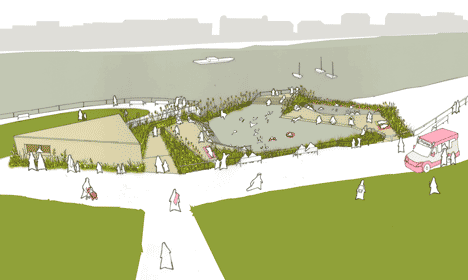
Thames Water plans to construct a new tunnel, dubbed the Super Sewer, which will remove 96 percent of the sewage currently entering the river and is scheduled for completion in 2023, if planning permission is granted.
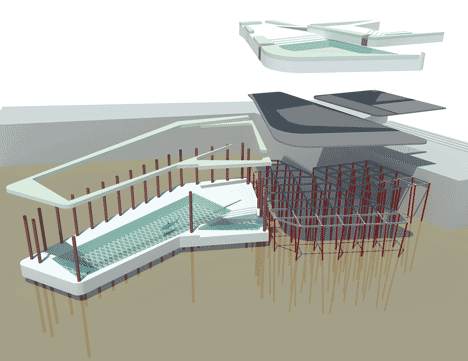
Studio Octopi proposes building pools at two of the Super Sewer construction sites; Shadwell in the east of the city and Blackfriars Bridge in central London.
"Imagine the views from the waterline, downstream to the London Eye, upstream to the City," said Romer-Lee of the Blackfriars location. "Whether it’s for sport or leisure, bringing these alternative uses to the heart of cities unites diverse communities, encourages physical activity and invigorates the flora and fauna of our much overlooked river."
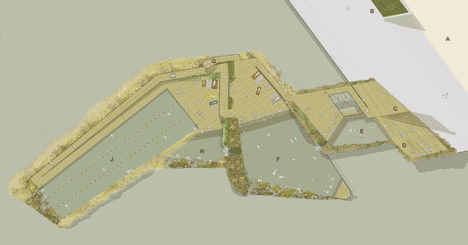
Romer-Lee pointed out that the concept doesn't rely on the Super Sewer, but does require the UK government to take steps to improve the current sewage system and water quality in The Thames, which currently falls below European standards.
The architects worked with structural engineering specialist Civic Engineers to develop the design, which includes a pair of pools supported by a concrete slab and raised to the height of the high water mark on a series of steel columns. The pools would be replenished with fresh river water at high tides.
A further pool made from concrete waffle slabs anchored to fixed posts would float on the surface of the river, rising and falling with the tide while protecting swimmers from the tidal currents.
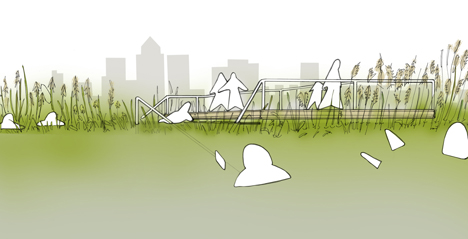
Concrete decks with cast-in air pockets would surround the pools, providing places for swimmers to rest and counterbalancing heavy gabion cages filled with rocks and plants.
Jonathan Cook Landscape Architects contributed ideas for planting to enhance the natural look of the pools, including reeds to fringe the floating pool and perennials and ferns along the wharf edge. Over time, algae, ferns and saline plants would cover the supporting structure as it gradually weathers, while native plants would colonise the planted areas.
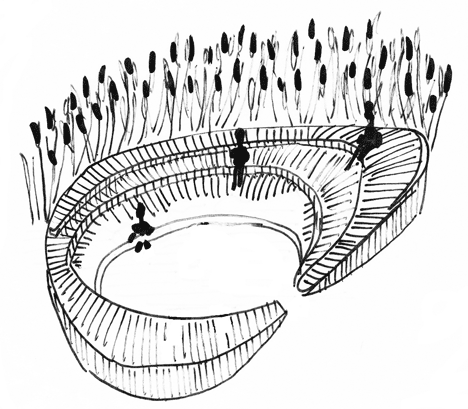
Studio Octopi's design was one of five proposals created by teams chosen to submit ideas for a project called London As It Could Be Now, developed by The Architecture Foundation with architecture firm Rogers Stirk Harbour + Partners.
The concepts for new ways to make the most of the River Thames were presented last autumn as part of the exhibition Richard Rogers RA: Inside Out, at London's Royal Academy.
Images are by Picture Plane.
The architects sent us the following details:
London-based architects Studio Octopi propose reintroducing swimming in the tidal River Thames
As a result of the collaborative London As It Could Be Now project, developed by The Architecture Foundation with Rogers Stirk Harbour + Partners and the Royal Academy of Arts, Studio Octopi were selected as one of five teams to work up new visions for the Thames. The teams were encouraged to explore ideas that increased interaction with the waterway and raised awareness of this important artery running through the Capital. Thames Baths Project is collaboration between architects Studio Octopi, Civic Engineers and Jonathan Cook Landscape Architects.
In 1865, Sir Joseph Bazalgette’s London sewage system was opened. 150 years later the sewers are at the limits of their capacity. In 2012, 57 combined sewer overflows discharged 39 million tonnes of sewage into the River Thames.
Thames Water is planning the Thames Tideway Tunnel, or 'Super Sewer', for completion in 2023. This tunnel will remove 96% of the sewage currently entering the river. Instead of a weekly discharge into the river, the Super Sewer will overflow a maximum of 4 times a year.
When Sir Joseph Baselgette's sewer system was finally completed in 1875 swimming in the River became a common occurence. In the same year a floating swimming baths opened on the foreshore at Charing Cross. Heated river water was pumped around an iron and glass structure. Then in 1878 Agnes Beckwith 'the greatest lady swimmer in the world' safely swam 20 miles from Richmond to Westminster and back again. The improvements in water quality open the possibility for once again swimming in the tidal Thames. The Thames Baths Project looks to re-establish an intimate and playful link between Londoners and the historic lifeblood of the city, the River Thames. Here is an opportunity for Londoner's to reclaim ownership of their largest outdoor public space.
Studio Octopi's proposals are focused on two of the Super Sewer construction sites: Blackfriars Bridge Foreshore and King Edward Memorial Park Foreshore. These sites were chosen for their contrasting London contexts. As well as creating a community resource and tourist attraction, its proposed that these floating and fixed aquatic landscapes should also continue to improve the ecology of the River Thames. Growing from planted rock cages (gabions) an array of native planting forms enclosure and frames views to the surrounding city. The fixed pools, lifted high on timber and steel piles, are replenished at high tide like coastal rockpools. The floating pools rise and fall with the tide offering a unique experience with the river. The sunken structure protects the swimmers from currents, whilst the planting offers tantalising views to the city beyond.
Intertidal Flora by Jonathan Cook Landscape Architects
Imagine swimming in the tidal river, surrounded by reeds that frame tantalising views of the city around you. The pools are not just for swimmers, but provide refuge and habitat for fish, birds and a wide range of flora.
Here in the heart of London is the upstream limit of saline plants on the Thames, and a series of layered habitats. From the algal slime at the base of the structure to the gabion-protected surface planting, the stages mimic salt marshes to freshwater wetlands.
As the supporting timbers weather they will be colonised by algae, ferns and saline plants such as sea beet and sea aster. The extensive planting of reeds around the pools will frame viewpoints edged with low sedums, and surface beds of yellow flag iris. The flooded pool will feature salt marsh species such as rushes and water plantains, while the wharf edge planting will be a relaxed mix of colourful perennials (red valerian) and ferns. All planted areas will soon be accompanied by naturally colonising plants, some native, others typical of London's introduced alien flora.
Structural Principles by Civic Engineers
The fixed structure consists of a randomly ordered grillage of small sectioned steel channels founded in the river bed and extending to a height just below the high water mark. Embedded within the frame will be non-structural timber members to encourage the colonisation by flora. The fixed pools are split across two levels and sit on a concrete slab suspended on the steel frame.
The second adjoining floating structure is free to rise and fall with the tide. This is restrained with a series of substantial fixed posts which allow the open concrete waffle slab to rise and fall. Surrounding the pools, a concrete deck with cast-in air pockets counterbalances the weight of the planted rock gabion cages. The concrete deck can be precast off site and floated up the river into position.